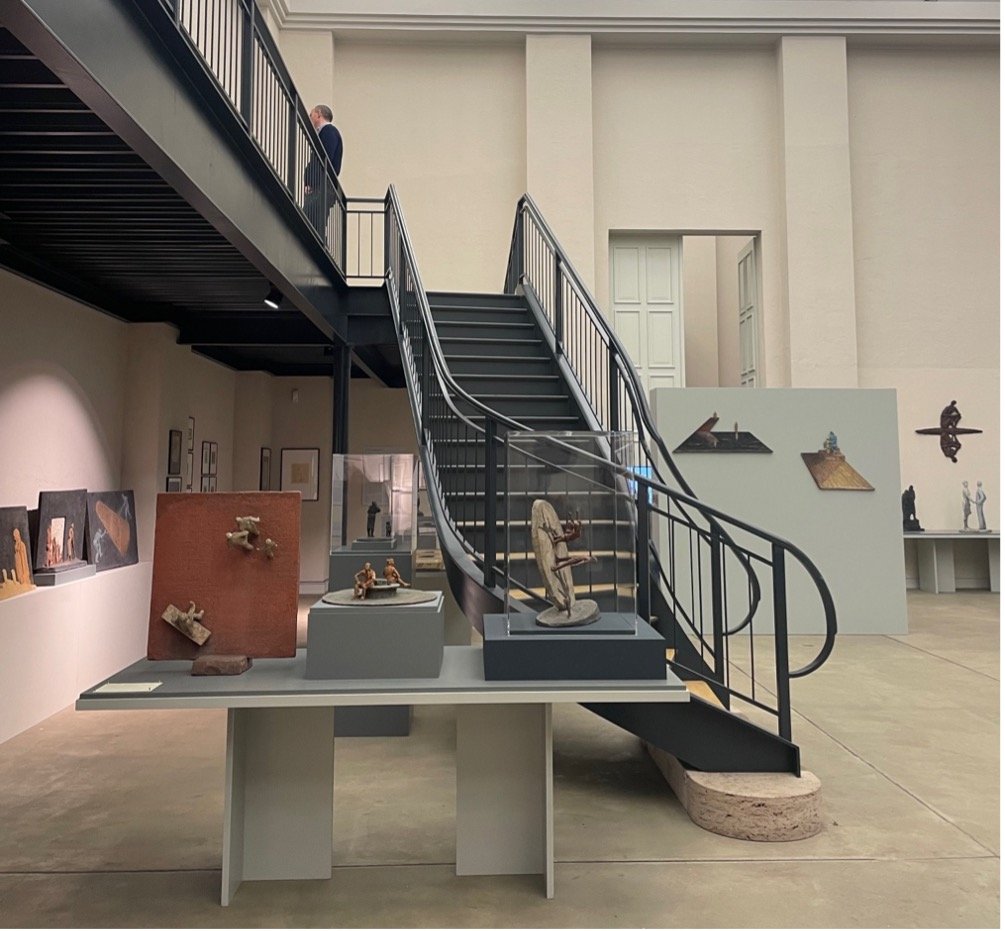Péri’s People: Peter László Péri at Kunsthaus Dahlem
By Anna Marweld
Peter László Péri’s dynamic exploration of movement and materiality has had an acute influence on the trajectory of contemporary art. Born in Budapest, Péri spent several years moving from metropolis to metropolis, including Paris, Vienna, and Berlin. Politicised from an early age, his work is frequently tinged with socialist principles. Having lived through the significant social and political upheaval of the early to mid-twentieth century, Péri’s artistic vision is identified by its willingness to go beyond traditional boundaries of art. His exhibition in Kunsthaus Dahlem, Berlin, offers a diverse and coherent survey of his artistic career which captures the bold innovation he was known for. Each work is imbued with an essence of kineticism – despite the rigid and immoveable materials Péri used for his sculptures, they seem to come alive before the viewer and interact within their own space.
[Figure 1] Installation view of Péri’s People, Kunsthaus Dahlem, Berlin. Photograph courtesy of the author.
The exhibition space is large and labyrinthine, with gorgeous high ceilings that allow the viewer’s eye to travel around the expanse of the room and rest on Péri’s intricate sculptural designs. A particularly interesting section on the right side of the room features busts of human heads, playfully – yet lovingly – painted in rust-coloured browns and sepias. Others are enclosed in glass cases, characterized by the roughness of the metal and bronze Péri is revered for. Each sculpture within the exhibition emits an aura of kinetic potential, poised on the brink of emancipation from their material confines. The exhibition space feels truly electrified, the viewer waiting with bated breath for the sculptures to pass beyond the cusp of metamorphosis into the plane of existence. Averting one’s gaze from these sculptures evokes a sensation tinged with excitement and possibility – a mere blink may mean relinquishing a precious opportunity to witness their covert spontaneous vitality. Péri invites us to contemplate upon the demarcation separating the zones of artificial artistic representations and reality.
[Figure 2] Exhibition display case, Kunsthaus Dahlem, Berlin. Photograph courtesy of the author.
The figures enclosed in the glass enclosures exude a semblance of Péri’s carefully crafted dynamism. Yet there is also something tragic about the figures’ contorted bodies, travelling around in an endless loop with clenched fists. We are reminded of the turbulence of Péri’s life, tainted by political and social tumult. Figures contorted like this, in combination with other fragmented figures and forms, are suggestive of the existential angst and trauma that defined the era of his work. His work is constructed as a pillar that stands the test of time against struggle, seeking to challenge the power structures that were accompanied by the rise of totalitarian regimes. Growing up in Budapest, Péri was exposed to a diverse cultural scene and studied at the Hungarian Academy of Fine Arts. Following the brutality of World War 1, the Treaty of Trianon resulted in Hungary losing significant areas of territory. The periods of financial impairment that followed, in combination with tumultuous political instability, left Hungary in a position of turmoil.
Péri eventually left Hungary amongst anti-Semitic persecution and entered London as an emigré. This provided him with the ability to experiment with his artistic endeavours, despite facing financial and linguistic barriers in his new home. He taught sculpture at various institutions in London, helping shape post-war Britain’s new art scene. Péri’s sculptures have a beautifully tactile quality, jagged edges of hard welded metal, that provide his work with a visceral and raw quality. They encourage the viewer to walk around the sculptures, taking in the intricacies of Péri’s work, and enter conversation with the artist through the physical markings he left behind.
[Figure 3] Peter László Péri, Rescue Men, 1942, concrete sculpture, exhibited at Kunsthaus Dahlem, Berlin. Photograph courtesy of the author.
Because Péri could often not afford bronze, he preferred to use concrete – a cheaper material he had already gathered some experience with. Concrete’s solidity and durability affect our physical perception of the artwork, but also remind us of its cultural connotations. When we view a concrete sculpture, we can feel it’s rough and grainy surface underneath our fingertips. It’s heaviness and density also provide an impression of resilience, of hard and long wear. The viewer feels the sculpture will exist in its rigid state for decades to come, drawing attention it its presence and commanding respect. As concrete is typically used in industrial contexts, Péri reminds us of the perils of urbanization and industrialization, pushing the boundaries of artistic innovation in a precursor to contemporary art movements such as arte povera.
Peter László Péri is an artist who deserves to be recognised as an innovator. His work is a rich tapestry woven with both struggle and resilience. Péri’s artistic oeuvre speaks of social justice and existential angst, but also of hope that persevered in the face of turbulent adversity and the unknown. The beautifully intricate textures of his work and their bold, fluid sense of movement creates sculptures that are hauntingly beautiful, making them impossible to forget.



